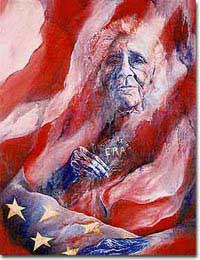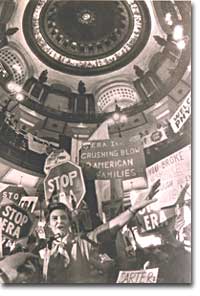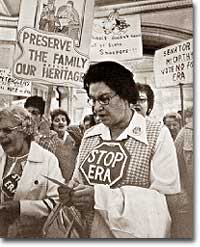


As founder of the National Women's Party, Alice Paul first introduced the Equal Rights Amendment to Congress in 1923. Paul would work for the passage of the ERA until her death in 1977.
"Equality of rights under the law shall not be abridged by the United States or by any State on account of sex."
This simple sentence comprised Section 1 of the Equal Rights Amendment (ERA), which was first proposed in Congress by the National Women's Party in 1923. Feminists of the late 1960s and early 1970s saw ratification of the amendment as the only clear-cut way to eliminate all legal gender-based discrimination in the United States.
Amending the Constitution is a two-step process. First, the Congress must propose the amendment by a two-thirds majority in both the House and Senate. After proposal, it must be ratified by three-fourths of the state legislatures. Organizations like the National Organization of Women (NOW) began a hard push for the ERA in 1970.

Phyllis Schlafly was perhaps the most visible opponent of the Equal Rights Amendment. Her "Stop ERA" campaign hinged on the belief that the ERA would eliminate laws designed to protect women and led to the eventual defeat of the amendment.
Leaders such as Gloria Steinem addressed the legislature and provided argument after argument in support of the ERA. The House approved the measure in 1970, and the Senate did likewise in 1972. The fight was then taken to the states. ERA-supporters had the early momentum. Public opinion polls showed strong favorable support. Thirty of the necessary thirty-eight states ratified the amendment by 1973.
But then the tide turned. From nowhere came a highly organized, determined opposition that suggested that ratification of the ERA would lead to the complete unraveling of traditional American society.
The leader of the Stop-ERA campaign was a career woman named Phyllis Schlafly . Despite her law degree, Schlafly glorified the traditional roles of American women. She heckled feminists by opening her speaking engagements with quips like "I'd like to thank my husband for letting me be here tonight." Schlafly argued that the ERA would bring many undesirable changes to American women.

The fight over the Equal Rights Amendment did not pit women against men — it pitted two ideologies against eachother.
Protective laws like sexual assault and alimony would be swept away. The tendency for the mother to receive child custody in a divorce case would be eliminated. The all-male military draft would become immediately unconstitutional. Those opposed to the ERA even suggested that single-sex restrooms would be banished by future courts.
Stop-ERA advocates baked apple pies for the Illinois legislature while they debated the amendment. They hung "Don't draft me" signs on baby girls. The strategy worked. After 1973, the number of ratifying states slowed to a trickle. By 1982, the year of expiration, only 35 states had voted in favor of the ERA — three states shy of the necessary total.
Feminist groups maintained that a serious blow was struck toward the idea of gender equity in the United States. They also saw women divided against other women. Despite early gains by the feminist movement, the rise in social conservatism led Americans of both genders to draw limits on a constitutionally mandated equality between the sexes.
Shirley Chisholm's "Equal Rights for Women."
Shirley Chisholm delivered this address to the House of Representatives on May 21, 1969, in support of the Equal Rights Amendment. The Amendment was passed in both houses of Congress, but was never ratified. Read the text of her speech which contains the famous line: "If [a recent female graduate] walks into an office for an interview, the first question she will be asked is, "Do you type?'"
Amending the Constitution
Want to change the Constitution? Feminists and dozens of others have tried and now you can learn how it's done at this site from The U.S. Constitution Online. Have a look at the two (yes, only two!) ways that the Constitution can be amended. You'll also see some of the famous amendments that failed — like the ERA — and some of the amendments that have been proposed in recent years.
The Equal Rights Amendment
Navigate through this site to learn all the basics you need to know about the Equal Rights Amendment. The Equal Rights Summit, a volunteer organization, guides you through why we need each section of the Amendment, the history of the Amendment and what is being done to supply equal rights.
Exploring Constitutional Conflicts
Douglas Linder, a professor of Law at the University of Missouri, Kansas City, questions conflicts present in the Constitution. Linder question the use of and need for the Equal Rights Amendment. Answer some of the questions he poses to decide for yourself.
Affirmative Action
Equal Rights Advocates believes that women still need affirmative action. This advocacy group provides statistics, relevant court cases and personal stories to support the call for affirmative action.
Alice Paul quotations
I never doubted that equal rights was the right direction. Most reforms, most problems are complicated. But to me there is nothing complicated about ordinary equality.
-Alice Paul
Gloria Steinem
A woman without a man is like a fish without a bicycle. -Irina_Dunn (not Gloria Steinem)
The Equal Rights Amendment
The Equal Rights Amendment was written in 1921 and was introduced in every session of Congress from 1923 until its passage by both houses of Congress in 1972, when it passed to the states for ratification, failing to get the required support in 3/4 of the states. Read more about the current state of the very-much-alive movement to realize this century-old idea.